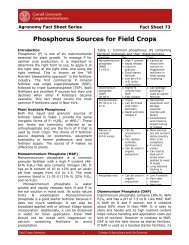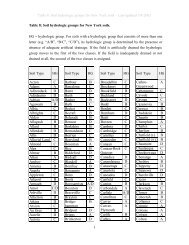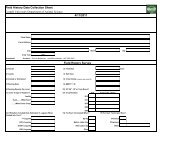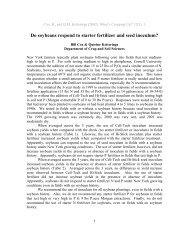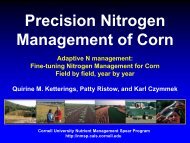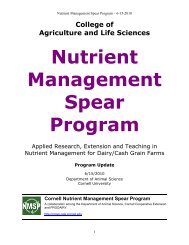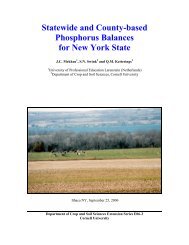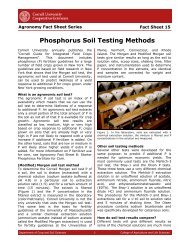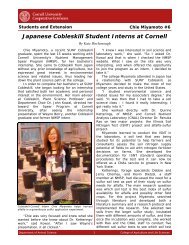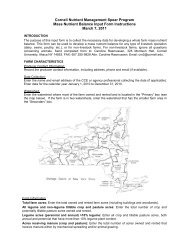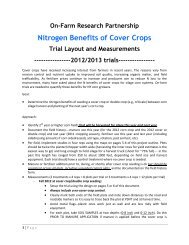Value of Manure Calculator - Cornell University Nutrient ...
Value of Manure Calculator - Cornell University Nutrient ...
Value of Manure Calculator - Cornell University Nutrient ...
- No tags were found...
You also want an ePaper? Increase the reach of your titles
YUMPU automatically turns print PDFs into web optimized ePapers that Google loves.
<strong>Value</strong> <strong>of</strong> <strong>Manure</strong><strong>Calculator</strong>What is the fertilizer replacement value <strong>of</strong> manure? Whatdoes it cost to apply? How much can I apply given labor andtime constraints in the spring?Caroline Rasmussen, Patty Ristow, Karl Czymmek, andQuirine Ketterings<strong>Manure</strong> as <strong>Nutrient</strong> SourcePrimary macronutrients:Nitrogen (N), phosphorus (P), potassium (K)Secondary macronutrients:Calcium (Ca), magnesium (Mg), sulfur (S)Micronutrients:Iron (Fe), boron (B), copper (Cu), chlorine(Cl), Manganese (Mn), molybdenum (Mo),zinc (Zn), cobalt (Co), and nickel (Ni)<strong>Cornell</strong> <strong>University</strong> <strong>Nutrient</strong> Management Spear Programhttp://nmsp.cals.cornell.eduAvailable N =<strong>Manure</strong> as Nitrogen SourceUrineUnstable Organic N(Fast N)Urea - mineralizedrapidly to plantavailable Ammonium ammoniumNInorganic NAmmonium Nfrom presentapplicationTotal <strong>Manure</strong> Nitrogen+Mineralized slowlyduring the year <strong>of</strong>applicationMineralized organicN from presentapplicationFecesStable Organic N.(Slow N)Organic N+Residual -mineralized veryslowly in future yearsMineralizedorganic N frompast applications<strong>Manure</strong> as Nitrogen SourceAn example <strong>of</strong> a manure analysis:% lbs/ton lbs/1000gallonsTotal Nitrogen (N) 0.41 8 34Ammonium Nitrogen 0.19 4 16Organic Nitrogen 0.22 4 18Phosphorus (P) 0.08 2 7Phosphate Equivalent (P 2 O 5 ) 0.18 4 15Potassium (K) 0.26 5 22Potash Equivalent (K 2 O) 0.32 6 27Ammonium N in <strong>Manure</strong>• If incorporated in the fall, assume 100% loss.• If applied as sidedress injection for row crops,assume 100% fertilizer equivalent.• For spring application:Incorporation within:1 2 3 4 5 >5 d after spreading65 53 41 29 17 0 % availableOrganic N in <strong>Manure</strong>Current Last 2 yearsyear year agoCow manure
<strong>Manure</strong> as Nitrogen SourcePractice Question:‣ How much manure do we need to apply to meetcorn N requirements given the following scenario? N requirement: 50 lbs N/acre. <strong>Manure</strong> is applied in this year only (i.e. no pastmanure applications). <strong>Manure</strong> was surface applied, no incorporation. <strong>Manure</strong> contains 5 lbs organic N and 4 lbsammonium N per ton. Dry matter content <strong>of</strong> the manure is 8%.<strong>Manure</strong> as Nitrogen SourceAnswer:‣ <strong>Manure</strong> is surface spread without incorporationso all ammonium N is lost as ammonia.‣ Per ton <strong>of</strong> manure, there are 5 lbs <strong>of</strong> organic N.‣ In the first year 35% <strong>of</strong> the organic N will beavailable for manure with less than 18% drymatter.‣ Thus, per ton <strong>of</strong> manure there is 0.35 * 5 = 1.75lbs N.‣ To obtain 50 lbs <strong>of</strong> N, we need to apply 50 / 1.75= 29 tons/acre <strong>of</strong> this manure.<strong>Manure</strong> as Nitrogen SourceAdditional question:‣ How much P 2 O 5 and K 2 O are supplied withthe 29 tons <strong>of</strong> manure?Given: 5 lbs <strong>of</strong> P 2 O 5 per ton <strong>of</strong> manure.6 lbs <strong>of</strong> K 2 O per ton <strong>of</strong> manure.Answer:5 * 29 = 145 lbs P 2 O 5 /acre!!!6 * 29 = 174 lbs <strong>of</strong> K 2 O/acre<strong>Manure</strong> as Nitrogen SourceAnother scenario:‣ How much manure do we need to apply to meetcorn N requirements given the following scenario? N requirement: 50 lbs N/acre. <strong>Manure</strong> is surface applied in the spring andincorporated within one day. <strong>Manure</strong> contains 5 lbs organic N and 4 lbsammonium N per ton. Dry matter content <strong>of</strong> the manure is 8%. <strong>Manure</strong> is applied in this year only.<strong>Manure</strong> as Nitrogen Source‣ <strong>Manure</strong> is incorporated within one day in the springso 65% <strong>of</strong> the ammonium N is conserved andavailable is 0.65 * 4 = 2.6 lbs/ton.‣ Per ton <strong>of</strong> manure, there are 5 lbs <strong>of</strong> organic N.‣ In the first year 35% <strong>of</strong> the organic N will beavailable for manure with less than 18% dry matter.‣ Thus, per ton <strong>of</strong> manure there is 0.35 * 5 = 1.75 lbsN from the organic fraction.‣ Total N supply by the manure is 2.6 + 1.75 = 4.35lbs/ton.‣ To obtain 50 lbs <strong>of</strong> N, we need to apply 50 / 4.35 =11 tons/acre.<strong>Manure</strong> as Nitrogen SourceAdditional question:‣ How much P 2 O 5 and K 2 O are supplied with the11 tons <strong>of</strong> manure?Given: 5 lbs <strong>of</strong> P 2 O 5 per ton <strong>of</strong> manure.6 lbs <strong>of</strong> K 2 O per ton <strong>of</strong> manure.Answer:‣ 5 * 11 = 55 lbs P 2 O 5 /acre(compare to 145 lbs when NH 4+ is not conserved!!!)‣ 6 * 11 = 66 lbs <strong>of</strong> K 2 O/acre(compare to 174 lbs when NH 4+ is not conserved!!!)2
<strong>Manure</strong> as Nitrogen SourceAnother scenario:‣ How much manure do we need to apply to meetcorn N requirements given the followingscenario? N requirement: 50 lbs N/acre. <strong>Manure</strong> is injected in the spring. <strong>Manure</strong> contains 5 lbs organic N and 4 lbsammonia N per ton. Dry matter content <strong>of</strong> the manure is 8%. 32 tons <strong>of</strong> the same manure were appliedin each <strong>of</strong> the two previous years.<strong>Manure</strong> as Nitrogen SourceAnswer:‣ From organic N in the 32 tons <strong>of</strong> manure applied two yearsearlier, 5% will be mineralized this year: 32*5*0.05=8 lbs <strong>of</strong> N.‣ From the organic N in the 32 tons <strong>of</strong> manure applied lastyear, 12% will be mineralized this year: 32*5*0.12=19 lbs N.‣ Total requirement for this year is: 50-8-19=23 lbs N/acre.‣ <strong>Manure</strong> is injected in the spring so 65% <strong>of</strong> the ammonia N isconserved and available is 0.65 * 4 = 2.6 lbs/ton.‣ Per ton <strong>of</strong> manure, there are 5 lbs <strong>of</strong> organic N.‣ In the first year 35% <strong>of</strong> the organic N will be available: 0.35 *5 = 1.75 lbs N per ton <strong>of</strong> manure.‣ Total N supply by the manure is 2.6 + 1.75 = 4.35 lbs/ton.‣ To obtain 23 lbs <strong>of</strong> N, we need to apply 23 / 4.35 = 5tons/acre.<strong>Manure</strong> as Phosphorus Source<strong>Manure</strong> applications:1. No adjustments are made for residualP from sod or manure (soil testreflects past applications).2. Recommendations should be adjustedfor present year manure application!!!!<strong>Manure</strong> as Phosphorus Source P in manure is usually expressed as P and P 2 O 5 . Expressed “as received”. Expressed in %, lbs per ton, and lbs/1000 gallons. Conversion factors are:1% = 1 lb/100 lbs = 10 lb/1000 lbs = 20 lbs/ton• So % * 20 gives lbs per ton1 lb/ton = 4.17 lbs per 1000 gallonsN based application can result in excess P and K:PoultryLayer manure lbs/ton:37 N, 55 P 2 O 5 , 31 K 2 ONeeded to meet N: ~4 tonsNeeded to meet P:
Samples testing high or very high in P(percentage <strong>of</strong> all samples)Soil Test P (Morgan P lbs/acre)N based application can result in excess P and K:<strong>Manure</strong> as Phosphorus Source6050y = 4.7x + 26R 2 = 0.86908070Very High406030201050403020High/Optimum01976-1980 1981-1985 1986-1990 1991-1995 1996-20001001 2 3 4 5 6 7 8 9 10 11 12 13 14 15 16 17 18 19 20 21 22 23 24 25 26 27 28 29 30 31(Ketterings, Kahabka, Reid, 2005)<strong>Manure</strong> as Potassium Source<strong>Manure</strong> applications:1. No adjustments are madefor residual K from sod ormanure (soil test reflectspast applications).2. Recommendations shouldbe adjusted for presentyear manure application tosave on fertilizerapplication costs!!!!<strong>Manure</strong> as Potassium Source• K is not an environmental issue• K can be luxury consumed by plants• High K levels in forage (>2.5% K in forage or>1.5% in total diet) can lead to metabolicproblems post-calving (i.e. early lactation)• Milk Fever (Hypocalcemia)• Ketosis, mastitis, displaced abomasums• Dry cows need low K forage (
<strong>Value</strong> <strong>of</strong> <strong>Manure</strong> <strong>Calculator</strong><strong>Value</strong> <strong>of</strong> <strong>Manure</strong> <strong>Calculator</strong>Whole Farm Cost Associated with <strong>Manure</strong> ApplicationThe Problem: My farm has 2.6 million gallons <strong>of</strong> stored manure that isspread twice a year on 250 acres <strong>of</strong> land. What is the cost <strong>of</strong> investingin manure incorporation equipment?<strong>Value</strong> <strong>of</strong> <strong>Manure</strong> <strong>Calculator</strong>Whole Farm Cost Associated with <strong>Manure</strong> ApplicationThe Problem: My farm has 2.6 million gallons <strong>of</strong> stored manure that isspread twice a year on 250 acres <strong>of</strong> land. What is the cost <strong>of</strong> investingin manure incorporation equipment?<strong>Value</strong> <strong>of</strong> <strong>Manure</strong> <strong>Calculator</strong>Whole Farm Cost Associated with <strong>Manure</strong> Application<strong>Value</strong> <strong>of</strong> <strong>Manure</strong> <strong>Calculator</strong>Fertilizer replacement value and cost <strong>of</strong> exporting manureThe Problem: I have the opportunity to export manure to a neighbor –how much should I charge for it?<strong>Value</strong> <strong>of</strong> <strong>Manure</strong> <strong>Calculator</strong>Fertilizer replacement value and cost <strong>of</strong> exporting manureThe Problem: I have the opportunity to export manure to a neighbor –how much should I charge for it?6
<strong>Value</strong> <strong>of</strong> <strong>Manure</strong> <strong>Calculator</strong>How much time will it take me to spread manure?The Problem: I am considering using a drag-hose system – how manytrucks will I need to run from the storage to the fields?If you add an addition hauling truck, total labor hours and total clock hoursdecrease (as there is less down time for application operator).<strong>Value</strong> <strong>of</strong> <strong>Manure</strong> <strong>Calculator</strong>Tool to answer the following questions:• What is the break-even hauling distance?• What are the operating and ownership costs formy manure machinery?• What are the fertilizer replacement value andcost <strong>of</strong> exporting manure?• How much time (machinery and labor) will ittake to spread manure?<strong>Value</strong> <strong>of</strong> <strong>Manure</strong> <strong>Calculator</strong>• Agronomy Fact Sheet # 4:– Nitrogen Credits from <strong>Manure</strong>• Agronomy Fact Sheet # 18:– <strong>Manure</strong> Spreader Calibrations• Agronomy Fact Sheet # 38:– <strong>Manure</strong> Sampling, Handling and Analysis• Agronomy Fact Sheet # 53:– <strong>Manure</strong> Cost, <strong>Value</strong> and Time Management<strong>Calculator</strong>http://nmsp.cals.cornell.edu7



